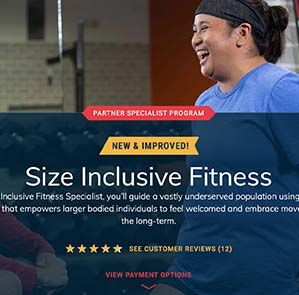Weight Focused vs. Weight Neutrality: How to Find the Balance Between Two Extremes

As a health and exercise professional who spends time on social media platforms, you have likely witnessed the “weight debate” that has participants leveling impassioned accusations at one another. From one camp, we hear that “an evidence-based approach to sustainable weight loss through healthy behavior change will combat many chronic diseases,” while the opposing camps insists that “pursuing health should not include weight achievement as a metric of success, as it can do more harm than good.” Is it possible both of these might be partially true?
How do we reconcile these potentially opposing perspectives, and help our clients understand them as well? In this article, we explore the complexities of this debate, shedding light on the challenges and opportunities presented to you as a health and exercise professional. We examine the unfortunate impact of extreme perspectives, as well as the benefits of those that are more moderate, including their impact on our clients’ perceptions of themselves and their health.
Introduction
The concept of body positivity has gained significant traction in the health and exercise space, sparking important conversations about acceptance, inclusivity and self-love within the health and fitness industry. As certified health and exercise professionals, we have all likely witnessed the powerful impact of this movement on our clients’ mental and physical well-being. However, amidst the growing popularity of body positivity, we find ourselves navigating a landscape characterized by two distinct extremes related to weight achievement.
On one side of the debate are those who take a position of weight neutrality. This perspective prioritizes health over size, and the Association for Size Diversity and Health—a powerful advocate in this space—has even coined and trademarked the term “Health at Every Size.” From this standpoint, weight neutrality takes precedence, emphasizing the promotion of healthy behaviors over fixating on reaching a particular number on the scale.
On the other side are those who promote a weight-focused approach as a means to reduce the risk of chronic diseases and other health complications. This approach underscores the large body of research that demonstrates obesity’s association with chronic disease, including diabetes, cardiovascular disease, hypertension and some cancers. It highlights the need for comprehensive prevention and management strategies that promote healthy behaviors, including balanced nutrition, regular physical activity and weight management, to reduce the burden of obesity-related morbidity and mortality. For this perspective, the adoption of healthy, sustainable behavior for lifelong weight management is a priority.
But what happens when those two perspectives are taken to extremes? For example, what happens when the focus on weight neutrality becomes so extreme that the health risks of obesity are denied? On the other hand, what happens when the emphasis on weight becomes excessively intense, shifting the focus toward pursuing an idealized and unattainable body type rather than prioritizing health?
And, what happens when that pursuit results in the marginalization of others?
Instead of veering toward either extreme, taking a balanced approach is more likely to guide us toward a healthy blend of body positivity and weight-focused strategies, empowering the client or participant to steer their own course. Somewhere between these two extremes is a “messy middle,” a more balanced narrative that acknowledges the importance of body acceptance while promoting a healthy weight and overall well-being.
In this space, we recognize that every individual is unique, with their own set of strengths, challenges and goals. We understand that disease prevention and risk reduction involve achieving a healthy weight, but also acknowledge that doesn't have to be the priority for every client. We also understand that true health encompasses much more than just a number on the scale; it encompasses mental, emotional and social aspects as well.
Important Terminology
As we examine these divergent perspectives, let’s first define a few terms central to the discussion. While body positivity and body inclusivity share similar goals of promoting acceptance and respect for all bodies, there are subtle differences between the two concepts.
Body positivity emerged as a movement primarily focused on challenging societal beauty standards and promoting self-love and acceptance regardless of body size, shape or appearance. It encourages individuals to embrace their bodies as they are and to celebrate diversity. Body positivity originated in part as a response to the pervasive body shaming and unrealistic beauty ideals perpetuated by mainstream media and popular culture.
Body inclusivity expands upon the principles of body positivity by emphasizing the importance of representation and inclusion for bodies of all shapes, sizes, abilities and identities. It recognizes that promoting acceptance and respect goes beyond body size alone and encompasses other factors such as disability, race, gender identity and age. Body inclusivity aims to create environments that are welcoming and accessible to all individuals, regardless of their physical attributes or characteristics.
Weight neutrality is an approach to health and wellness that prioritizes promoting healthy behaviors and attitudes toward oneself, regardless of changes in weight. It emphasizes the decoupling of weight from one’s sense of self-worth and focuses on fostering positive relationships with food, exercise and body image, rather than solely concentrating on achieving a specific weight or body size.
Weight focused is a perspective that emphasizes the importance of maintaining a healthy weight as part of overall disease prevention and health promotion. It acknowledges that excess weight can be a risk factor for various chronic diseases and conditions, and it advocates for sustainable interventions that support individuals in achieving and maintaining a healthy weight to reduce their risk.
Weight stigma and weight bias are related concepts that refer to negative attitudes, beliefs and stereotypes about individuals based on their body weight or size. While they are often used interchangeably, there are slight differences between the two terms. Weight stigma refers to the social and cultural attitudes, stereotypes and discrimination directed toward individuals who are perceived as being overweight or obese. It involves negative judgments, stereotypes and assumptions about a person’s character, worth and abilities based solely on their weight. Weight stigma can manifest in various forms, including teasing, bullying, discrimination in employment or healthcare settings, and media portrayals that reinforce negative stereotypes about larger bodies. Weight bias refers to the internalized attitudes and beliefs individuals hold about themselves or others based on weight. It encompasses personal biases, prejudices and stereotypes that influence how individuals perceive and interact with people of different body sizes. Weight bias can manifest in implicit or explicit attitudes, such as negative judgments, assumptions about a person's lifestyle or health behaviors, and differential treatment based on weight.
Who Decides Which Approach Is Best?
Although weight-focused and weight-neutral perspectives may appear to be diametrically opposed, they can harmoniously coexist within a framework of wellness and healthcare, with one crucial caveat: The decision of which approach to adopt must ultimately lie with the client. Put simply, if a client aims to shed 10 pounds to mitigate their diabetes risk and views the scale as an effective accountability tool, a weight-focused approach may be suitable. Conversely, if a client has endured a prolonged and intricate history of dieting and grappling with excess weight, and desires to prioritize health over weight, a weight-neutral approach may prove more beneficial for them.
However, when we walk these two approaches out to their extremes: Weight obsession at the cost of health, or weight rejection at the cost of health, nobody wins.
Even broader than the weight debate are the questions that health and exercise professionals should always be asking themselves before endorsing any wellness approach:
- Where does the science and evidence live? The answer may be both, but often not at the extremes.
- What can we do to support our clients in a way that celebrates who they are, honors their autonomy, and balances their behaviors to support their long-term health and well-being?
- What does the middle of any two extremes look like in action and practice?
- Where do the extremes come from? Understanding the origins of extreme viewpoints is crucial for promoting dialogue and mitigating the potential conflict.
The High Cost of Extremes on Either Side
Taking a weight-focused approach to its extreme might mean pursuing an idealized body image or, in some cases, high-level performance goals in sports or fitness at the expense of health. In their extreme, these pursuits could result in maladaptive eating behaviors and mental health conditions such as disordered eating behaviors, including rigid dietary rules, excessive calorie counting and food tracking, or compulsive and inflexible exercise routines. Even when individuals engage in these behaviors with the intention of improving their health or appearance, however, they may end up experiencing detrimental physical and mental repercussions, such as malnutrition, fatigue, injuries, and negative body image.
The weight-neutral approach, when taken to its extreme, could involve adopting unhealthy behaviors as a way of asserting autonomy or pushing back against the extremism of the weight-focused camp. This might include advocating that all foods in unlimited quantities are healthy or that weight bears no impact on health outcomes.
Let’s compare the consequences, however unintentional, of what could happen when weight-focused and weight-neutral approaches are taken to their extremes.
|
Weight Neutrality |
Weight Focused |
|
Health risks/chronic disease risk |
Overly restrictive practices |
|
Potential for neglect of weight-related health indicators, including the increased risk of inflammation, insulin resistance and dysregulation of metabolic hormones, which contribute to conditions like type 2 diabetes and cardiovascular disease |
Potential for developing eating disorders or disordered eating, including orthorexia, which is characterized by an obsession with healthy eating and an extreme preoccupation with consuming only foods that are perceived as pure, clean or “healthy” |
|
Denial of the relationship between weight and health |
Focus on weight alone, rather than health |
|
Disconnection from health goals |
Anxiety and depression |
|
Unbalanced lifestyle choices that may result in obesity-related comorbidities |
Nutritional deficiencies, bone loss, increased risk of injury |
|
Criticism or scrutiny if weight loss is pursued |
Food-related guilt or shame, poor relationship with foodCriticism or scrutiny if weight loss is pursued |
Ironically, both extremes share an “all-or-nothing” perspective, which is exactly what we try so hard to help our clients avoid. Binary thinking and self-talk, including “I never have to think about weight,” or “I always have to think about weight,” are equally harmful and get in the way of self-compassion and general self-care.
Ironically, both extremes share an “all-or-nothing” perspective, which is exactly what we try so hard to help our clients avoid. Binary thinking and self-talk, including “I never have to think about weight,” or “I always have to think about weight,” are equally harmful and get in the way of self-compassion and general self-care.
Coaching Toward the Messy Middle
Finding a balance between these two approaches requires open dialogue, education and support systems that empower individuals to make informed choices, while also promoting overall health and wellness. Encouraging a holistic approach to nutrition, activity and movement that prioritizes balanced eating, moderation, and sustainable practices can help clients navigate these seemingly opposing philosophies in their extreme.
So, how do we, as the professionals in this tug-o-war, exist in the “messy middle”? How do we honor our clients’ needs and allow them to pursue their goals, whatever those goals may be?
As you work to orient yourself and coach your clients toward the messy middle consider the nuances of this journey. To that end, we’ve created the following mnemonic—N.U.A.N.C.E.—to help you orient your compass when necessary.
- Navigate ambiguity: Navigating ambiguity in the "messy middle" requires us to embrace uncertainty and flexibility in our approach. As professionals, we must acknowledge that each client's journey is unique, and the path to their goals may not always be clear-cut. By staying adaptable, listening actively and being open to adjusting strategies as needed, we can better support our clients in finding their balance. This means fostering an environment where ambiguity is not feared but seen as an opportunity for growth and discovery, ensuring that our clients feel empowered to explore and define their own paths to health and wellness.
- Uplift wellness: Coach the client toward a balance between the opposing viewpoints and encourage the consideration of all aspects of their wellness, however they define it.
- Anchor the application: Anchor your practice in evidence-based practices. Familiarize yourself with the existing literature and apply evidence-based practice guidelines accordingly.
- Nurture understanding: Make an effort to grasp each client's individual viewpoint, their understanding of health and their vision for wellness.
- Center your practice on the client: Commit to a client-centered practice. They are the experts on themselves, and you are their guide.
- Embrace balance: Collaborate with your clients to set realistic and balanced goals that encompass different aspects of health. Encourage them to prioritize actions that promote overall well-being.
Steering toward the gray area, or messy middle, between the extremes of weight-centric and weight-neutral approaches guides us toward the achievement of health and well-being. Embracing this middle path allows individuals to prioritize health behaviors that foster physical, mental and emotional wellness. By doing this, the focus shifts from rigid rules on either side toward fostering a positive relationship with food, movement and self-care. It acknowledges that health is multifaceted and dynamic, requiring flexibility, self-compassion and continual learning.
Walking toward the messy middle means rejecting the unintentional extremes of any approach, as well as recognizing that our own progress is not always linear. It’s about finding balance amidst life’s challenges and uncertainties, cultivating resilience and prioritizing self-care. Ultimately, by embracing the messy middle, your clients have permission to honor what they want and can cultivate the healthiest and most fulfilling relationship with themselves and their bodies.
Expand Your Knowledge
Size Inclusive Fitness Specialist Program
When it comes to fitness, the larger-bodied demographic has different needs both psychologically and physically. The Size Inclusive Fitness Specialist Program, created by Louise Green, author, educator and award–wining fitness trainer whose expertise has been featured by more than 150 media outlets, offers in-depth, highly specialized training to remove barriers and help get your larger-bodied clients moving in a sustainable way.
A Space for Every Body: Addressing Weight Bias in the Fitness Industry
In this video training co-hosted by ACE and SELF Magazine, you will learn from a panel of experts how you can play a significant role in helping combat weight bias and stigma in the health and fitness industry. The panelists discuss what an inclusive fitness space looks like, best practices for working with clients who may have experienced weight bias, and much more. This dynamic conversation will equip you with the tools necessary to serve, understand and become an ally for people of all sizes.
More Articles
- Certified™: June 2024
The Best Investments to Make in Your Career Right Now
Contributor
- Certified™: June 2024
Make an Impact With Appreciative Inquiry and Coaching
Contributor
- Certified™: June 2024








